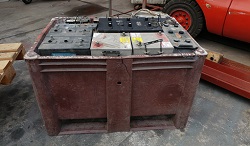Unbeatable nuclear security
Nuclear fuels are the most dangerous substances on Earth, and the most controlled. Stolen nuclear materials can end up in the hands of terrorists. Of particular concern to Europe and other regions are ‘dirty bombs’. Such devices use conventional explosives to disperse deadly radioactive dust particles. Standard security controls include use of radiation portal monitors (RPMs) at the checkpoints of nuclear facilities. Vehicles drive through a stationary frame upon which various kinds of passive radiation detectors are mounted. However, RPMs cannot detect materials shielded behind dense metals. To prevent similar thefts, the EU-funded IMPRINT project has developed new technologies able to detect shielded radioactive materials. The new scanners have been designed to supplement the weaknesses of existing RPM and X-ray technologies. Apart from the detector itself, IMPRINT also developed algorithms and software to construct images using the scanner data. Further project stages included field testing and preparation for commercialisation. Muon detectors The project’s key technology involves muon detection. Muons are fundamental subatomic high energy charged particles created in the upper atmosphere. Muons generally resemble electrons, except they are much heavier with high energy. Another key difference is muons’ ability to penetrate matter. “They have the highest known penetration of any charged particle on Earth,” says IMPRINT project leader David Yaish. The idea behind the IMPRINT scanner is that muons can penetrate via any dense cargo materials including and hidden shielded nuclear materials. In effect, muons cannot be shielded. In practice IMPRINT’s scanner system relies on a set of six mosaic detectors. Two layers of detectors are placed above the target object, and another two layers are placed underground below the target object. These four detectors measure the muons’ locations, the entry and exit angle. Two additional layers of detectors measure the momentum of each exiting muon. Using the data collected by the detectors, the project’s algorithms generate a 3D map of the materials’ densities within a vehicle or container to detect the hidden radioactive materials accordingly. In practice, this muon detection system is planned to be employed as part of the security chain in conjunction with other scanners. “An RPM or X-ray scanner is used as the primary inspection system, and the muon-based system will be used as a secondary inspection system to detect nuclear and shielding materials plus other contraband as explosives, weapons and other prohibited items,” explains Mr Yaish. Any vehicles that the primary scanners identify as suspicious would then be inspected by the muon system. It would not be cost effective to use muon detection for every vehicle. The project’s muon detection algorithms utilise the primary X-ray scanner data to enhance the detection performances, and at much lower cost compared to possible muon detection system used as a standalone primary system. Thanks to IMPRINT’s new muon detection system, Europe’s nuclear facilities will be more secure.
Keywords
IMPRINT, muon, nuclear, muon detection, nuclear materials, radioactive



